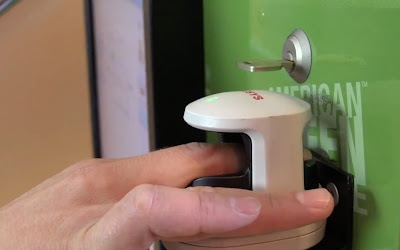 |
| Photo: American Green |
American Green has introduced a new vending machine prototype designed to allow the purchase of age, prescription or license restricted products. American Green and their technology partner PanPacific have worked non-stop over the last four years to bring this concept to market. The biometric verification technology used is the same used by the U.S. Military and large corporations requiring high levels of security.
Possible uses include dispensing alcohol and pharmaceuticals, including medical cannabis. Medical cannabis is currently available through vending at some dispensaries, but an employees verifies identity and prescription. The new vending system would allow patients greater privacy about their medical condition.
To use the new vending machine, a consumer would create an account using government ID and a copy of doctor’s prescription where needed. Authentication is made with a camera that scans the veins in one’s finger. Once ID is accepted, a touch screen is used to make product selection. A smart phone app has also been developed. A smart phone user after logging into their account and verifying ID would then show a QR code on their smartphone to dispense the product purchased.
David Gwyther, chairman and acting president at American Green believes, “This is a huge step forward for smart retail and the automated sale of regulated products.” One day soon we may be able to use a smart vending machine to get a beer at a ballpark, casino tokens at a casino, or common pharmaceuticals without visiting the pharmacy.
American Green introduces biometric vending machine system for age-restricted products
Published June 26, 2017 on PlanetBiometrics.com
Convenient cannabis: Vending machine checks ID
Zlati Meyer, May 11, 2017 for USA TODAY, Money



